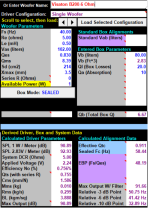I don't think the sealed box are really out of fashion... But if you want to reach a low bass extension, the enclosure has to be quite wide and built with the suitable Woofer to maintain the QTC=0.71, which represents the optimal compromise between volume / bass extension / linearity / impulse response.
To "rival" my DIY bass-reflex 3-ways 375L, I designed a 4-ways sealed enclosure, using a Beyma 12BR70, still available today :


With a neat VB at 115L, I should reach F3=44Hz, F6=34Hz, F10=24Hz, with the excellent transient and damping characteristics tied to the sealed enclosures...
No prototype is built for the moment, but it will come !
T
To "rival" my DIY bass-reflex 3-ways 375L, I designed a 4-ways sealed enclosure, using a Beyma 12BR70, still available today :
With a neat VB at 115L, I should reach F3=44Hz, F6=34Hz, F10=24Hz, with the excellent transient and damping characteristics tied to the sealed enclosures...
No prototype is built for the moment, but it will come !
T
Manufactures seldom use "efficiency", describing a loudspeaker with an 80dB sensitivity at 40Hz as having 0.6% efficiency does not sell wellAll that aside where are efficiency and sensitivity defined? The manufacturers often cloud the two. I would think efficiency should be in percent, 1 watt in .5 watts out is 50%.
Sensitivity is usually defined as on axis SPL in dB at 1 watt electrical input, measured at 1 meter.
A cone loudspeaker’s sensitivity is usually measured using an infinite baffle, a half sphere radiation.
The voltage used is often 2.83 Volts RMS, which is 1 watt into an 8 Ω (nominal) speaker impedance, though that same voltage would be double the power into half the impedance, or half the power into double the impedance.
Since a speaker’s sensitivity and Q (radiation pattern) varies with frequency, a single sensitivity number is not very useful in comparing loudspeakers.
Converting sensitivity to efficiency is possible.
https://sengpielaudio.com/calculator-efficiency.htm
The 0 dB reference level for sound is 10−12 watts.
1 acoustical watt is 120 dBSPL.
The standard measurement for a cone loudspeaker is done with it mounted flush on an infinite baffle radiating into half space at a distance of r = 1 m.
The resultant factor 2π × r2 (area of a half sphere) equals −8 dB. Therefore an efficiency of 1 = 100 % for a sensitivity of 120 − 8 = 112 dB.
This calculation is correct for a loudspeaker radiating in a hemisphere, 2π. Otherwise you must add the Q factor because of directionality.
Spherical radiation Q = 1, hemisphere Q = 2, quarter sphere Q = 4, and eighth sphere Q = 8.
Note that using the above calculation, efficiency of over 100% is possible for high Q devices like narrow coverage horns which can have on axis sensitivity of well over 112dB.
If the horn driver had uniform radiation over a half sphere, it’s efficiency would be under 50%.
Art
The HighEnd Kartesian are really interesting units - but so expensive. You can buy a Purifi for that money.
That's the thought I have with everything they have basically.The HighEnd Kartesian are really interesting units - but so expensive. You can buy a Purifi for that money.
Unfortunately I have to say.
